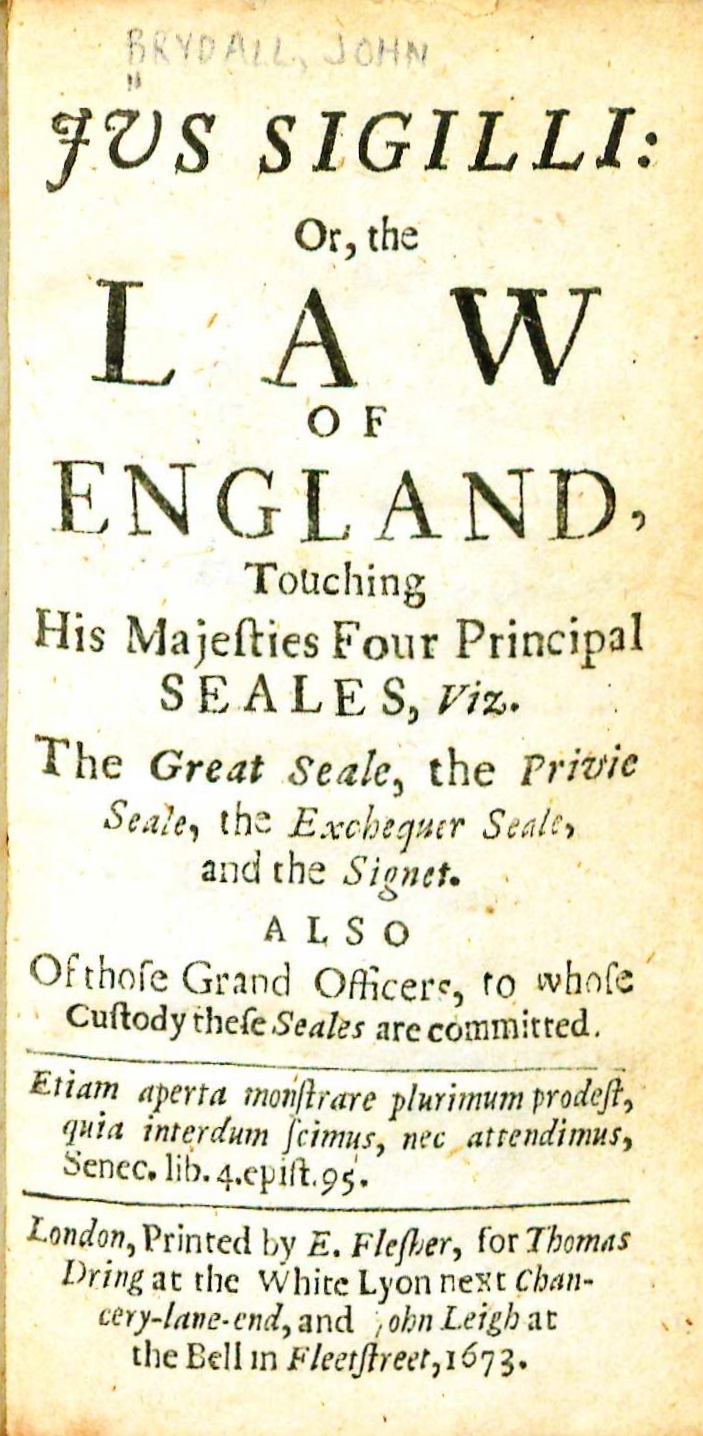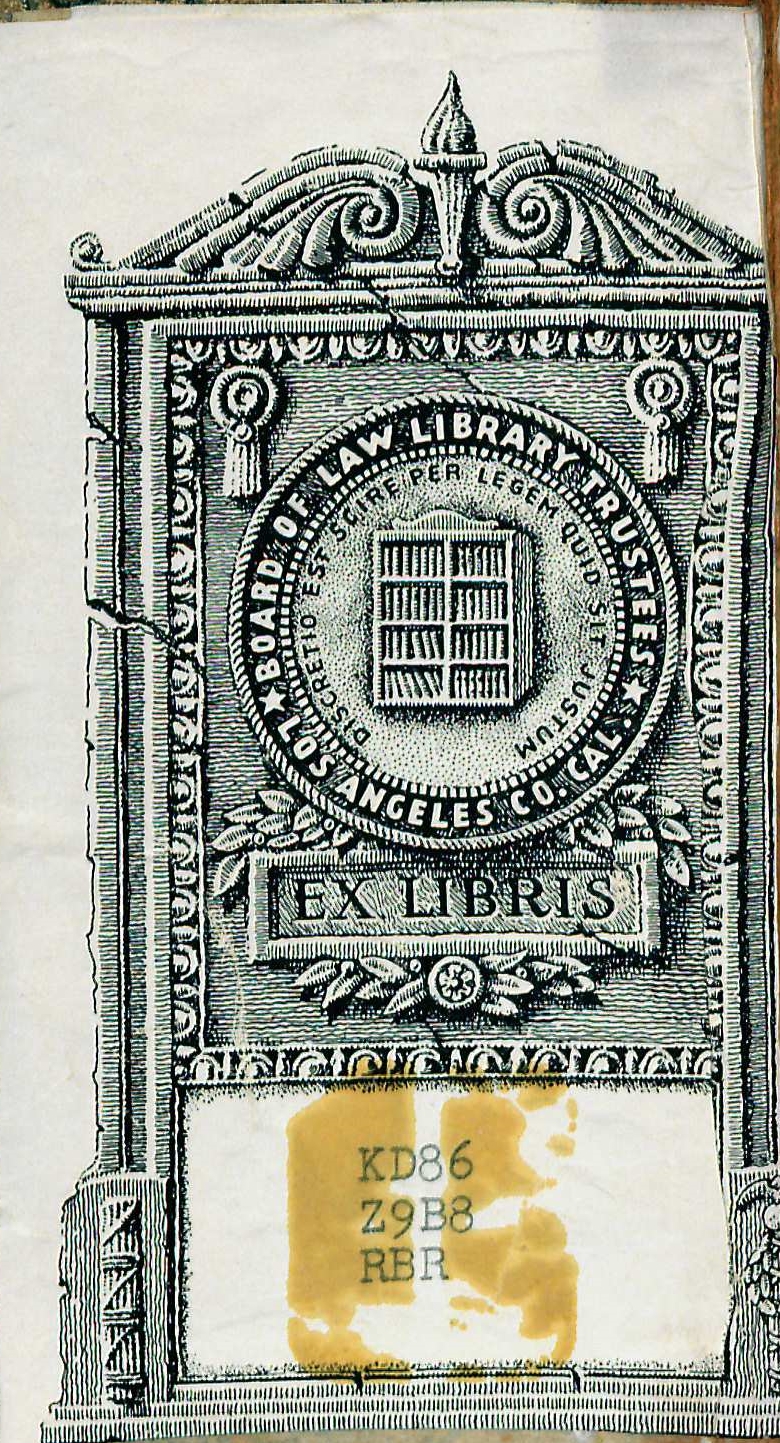Difference between revisions of "Jus Sigilli"
(Created page with "{{DISPLAYTITLE:''Jus Sigilli''}} ===by John Brydall=== <big>''Jus Sigilli, or, The Law of England, Touching His Majesties Four Principal Seales, viz. the Great Seale, the Priv...") |
(No difference)
|
Revision as of 16:21, 30 June 2014
by John Brydall
Jus Sigilli, or, The Law of England, Touching His Majesties Four Principal Seales, viz. the Great Seale, the Privie Seale, the Exchequer Seale, and the Signet
| Jus Sigilli | |
|
Title page from Jus Sigilli, George Wythe Collection, Wolf Law Library, College of William & Mary. | |
| Author | John Brydall |
| Published | London: Printed by E. Flesher, for Thomas Dring and John Leigh |
| Date | 1673 |
| Language | English |
| Pages | [4], 129, [6] |
| Desc. | 12mo (13 cm.) |
John Brydall (Bridall) was born in Chatsworth, Devonshire in 1635 and lived at least until 1705 (the last known date of his published work).[1] He was the son of John Brydall who was also a lawyer and a Barrister at Lincoln's Inn (one of the four Inns of Court in London). Brydall entered Queen's College in 1652 and graduated in 1655.[2] Prior to graduating, he enrolled as a low ranking member at Lincoln's Inn and was considered the obvious choice to replace his father upon his stepping down.[3] At some point in his legal career, it appears that he acted as secretary to Sir Harbottle Grimston, Master of the Rolls.[4] While one source indicates that by the time of his death he had authored thiry-six legal works, there seems to be some confusion between what he wrote and what his father may have written.[5] Given his position with the Master of the Rolls, it is very likely that he, and not his father, was the author of Jus Sigilli.[6]
Jus Sigilli is a detailed description of the four principal seals of England which include the Great or Broad Seale, the Privie Seale, the Exchequer Seale and the Signet.[7] The Great or Broad Seale is used by the Lord Chancellor to denote the approval and authority of the king. Charters, commissions, or grants from the king must have the mark of the Great Seale in order to carry any authority.[8] The Privie or Little Seale was used by the Lord Privie Seale to authorize the use of the Great Seale on important documents, or as a authorization itself on documents of lesser importance.[9]
The Chancellor of the Exchequer is a more judicial position in control of financial matters relating to the Crown; most notably issues pertaining to tax revenue collected for the Crown.[10] The mark of the Exchequer Seal was required on all documents coming from the Chancellor of the Exchequer as it represented the authority of the Crown.[11]
The Signet is the personal seale of the Crown with the Principal Secretary having custodial repsonsibilities. Personal letters, patents, or other matters derived directly from the Crown would receive the mark of the Signet. If the matter was of great importance, it would then move to the Lord Privie Seal and then from there to the Lord Chancellor to receive the mark of the Great Seal.[12]
Evidence for Inclusion in Wythe's Library
When trying to identify the books Thomas Jefferson sold to the Library of Congress within the library's vast collection, E. Millicent Sowerby discovered a copy of Jus Sigilli with a manuscript note which she attributed to George Wythe, "On page 9 is written the number 203 in what may be the handwriting of George Wythe."[13] Records of the Jefferson sale indicate he did sell a copy of the first edition (1673) of John Brydall's Jus Sigilli to the Library of Congress. Whether the book Sowerby identified was actually Wythe's, or in fact Jefferson's, is unknown. This Brydall title does not appear in the Jefferson Inventory of books Jefferson created upon receiving Wythe's library. Only one of the George Wythe Collection sources, Brown's Bibliography,[14] includes Jus Sigilli. Brown does make note of Sowerby's tenuous link to Wythe. Despite the uncertainty of Wythe ownership, the Wolf Law Library purchased a copy of the 1673 edition.
Description of the Wolf Law Library's copy
Bound in quarter calf with marbled boards. Includes the bookplate of the Los Angeles County Law Library on the front pastedown.
Find this book in the William & Mary's online catalog.
References
- ↑ Michael de L. Landon, "Brydall, John (b. c.1635, d. in or after 1705?)" in Oxford Dictionary of National Biography, accessed 6 December 6, 2013.
- ↑ John Richard Magrath, The Queen's College (Oxford: The Clarendon Press, 1921), 2:54.
- ↑ Landon, "Brydall, John."
- ↑ Magrath, The Queen's College.
- ↑ Landon, "Brydall, John," and Magrath, The Queen's College.
- ↑ Landon, "Brydall, John."
- ↑ John Brydall, Jus Sigilli, or, the Law of England Touching His Majesties Four Principal Seales Viz., the Great Seale, the Privie Seale, the Exchequer Seale, and the Signet (London: Printed by E. Flesher, for Thomas Dring and John Leigh, 1673).
- ↑ Ibid.
- ↑ Ibid.
- ↑ http://en.wikipedia.org/wiki/Exchequer
- ↑ Brydall, Jus Sigilli.
- ↑ Ibid.
- ↑ E. Millicent Sowerby, Catalogue of the Library of Thomas Jefferson, 2nd ed. (Charlottesville: University Press of Virginia, 1983), 2:196 [no.1727].
- ↑ Bennie Brown, "The Library of George Wythe of Williamsburg and Richmond," (unpublished manuscript, 2009, rev. May, 2014) Microsoft Word file. Earlier edition available at: https://digitalarchive.wm.edu/handle/10288/13433.

